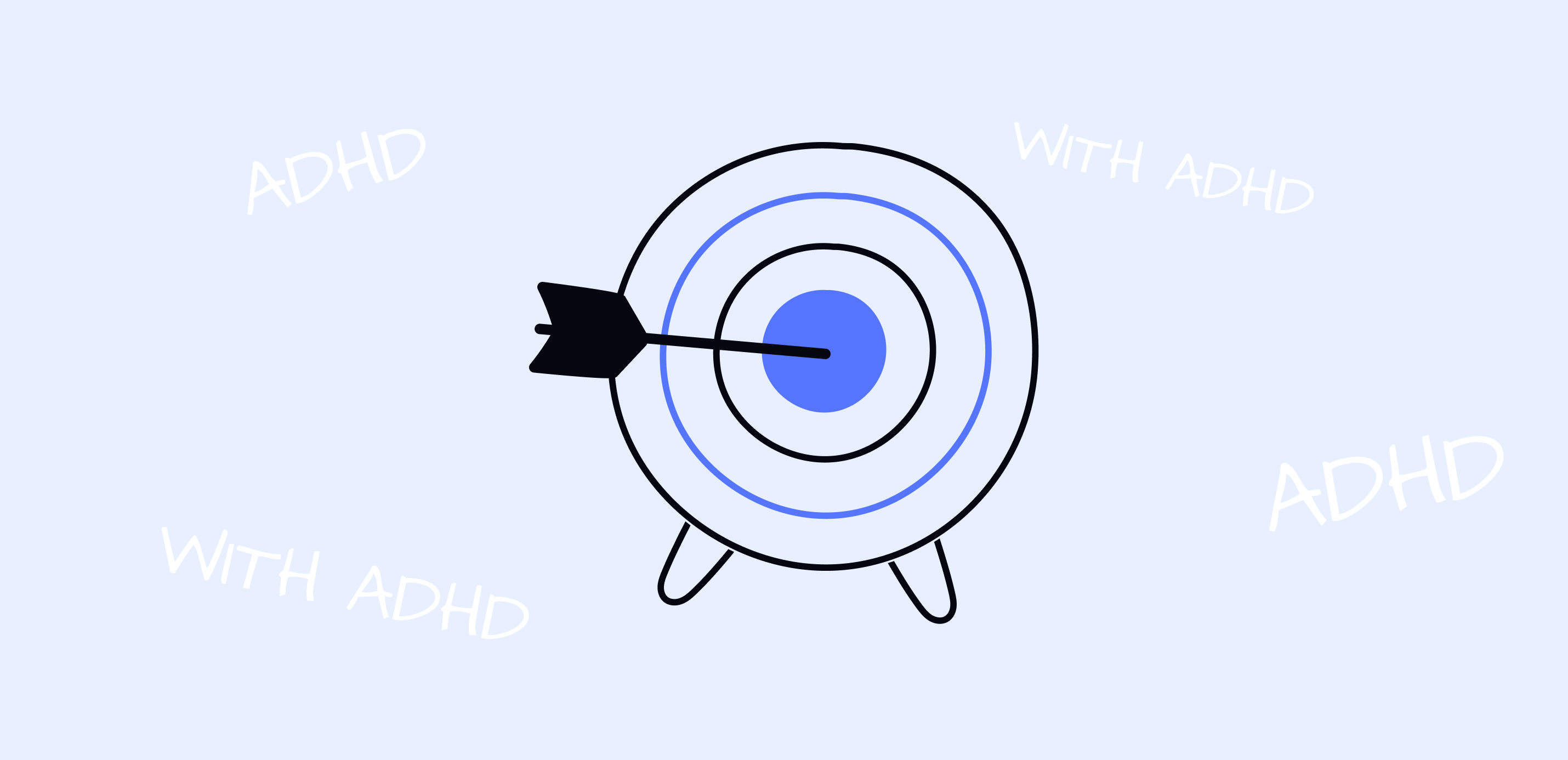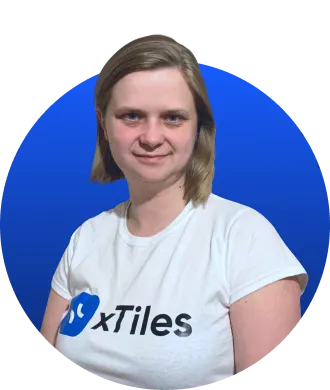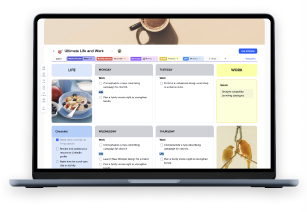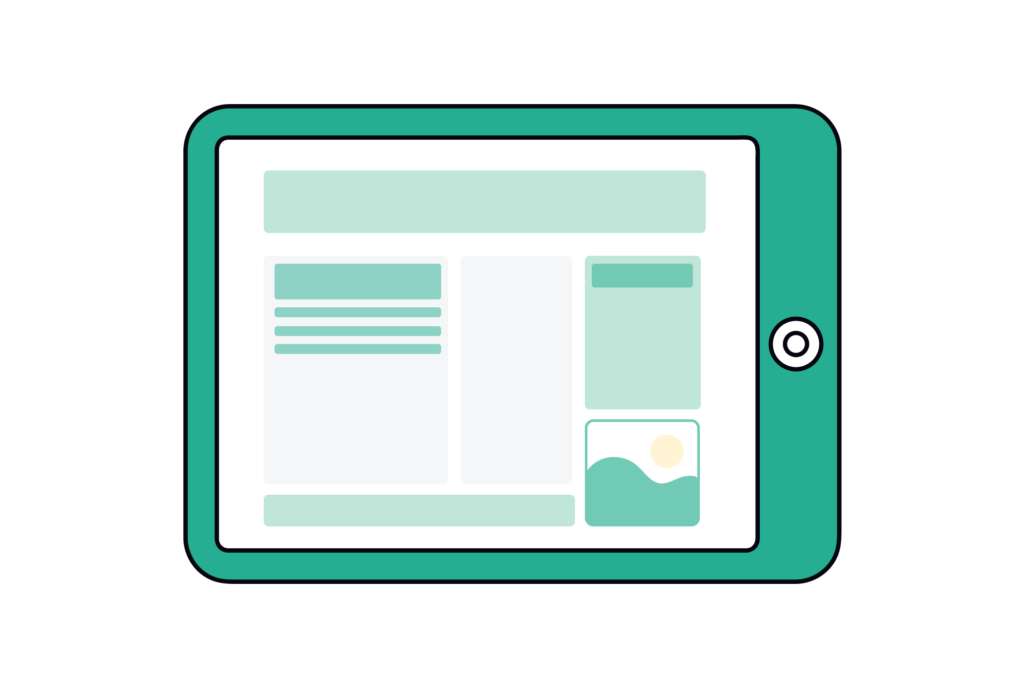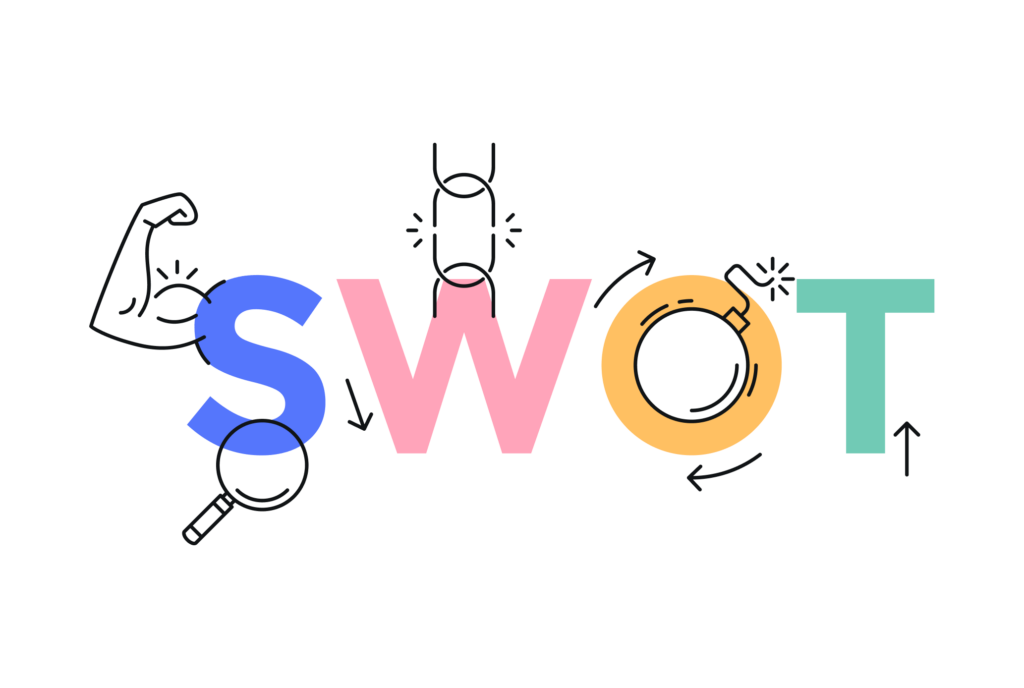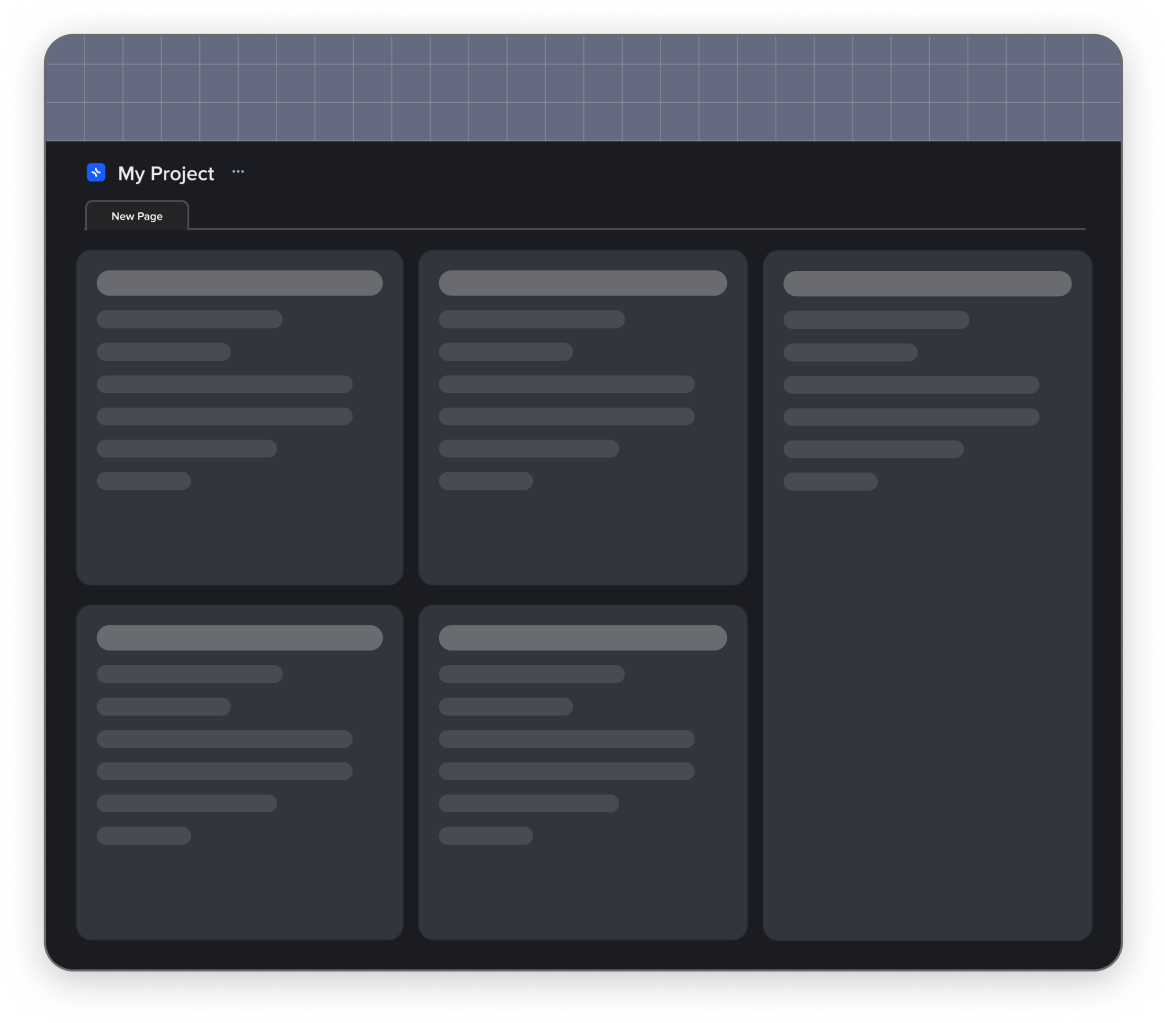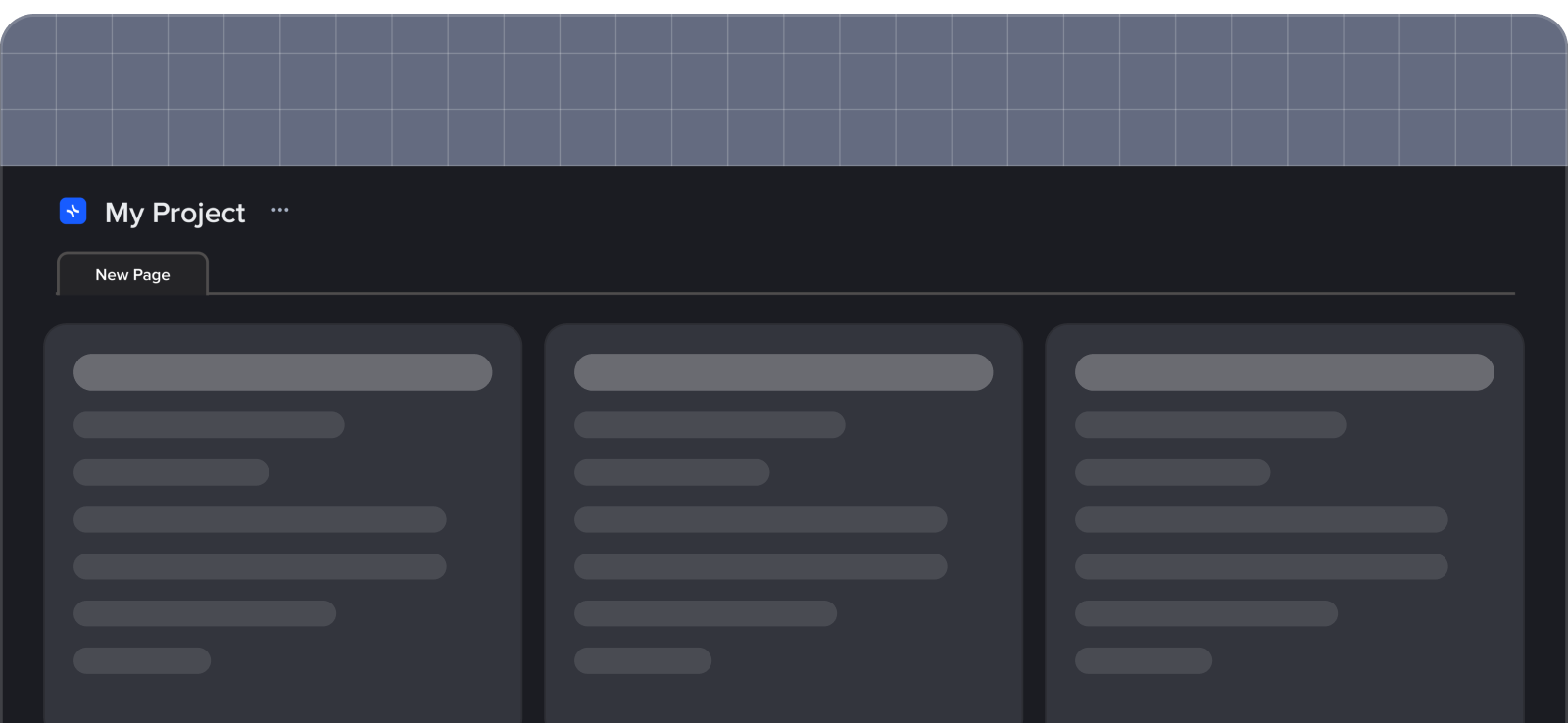People with Attention Deficit Disorder have a tough time with everyday productivity. Whether it’s big responsibilities at work or household chores, they can’t focus, get their thoughts together, and finish projects. Instead, they feel overwhelmed, get high-stress levels, and face the consequences their symptoms bring.
But it’s possible to manage ADHD symptoms and be more productive with the right tools and resources. The xTiles ADHD tool can help you stop distractions, get organized, and break things down into smaller bits. As a result, you may reduce your stress, feel successful in situations that normally discourage you, and turn impossible tasks into achievable goals.
This article has practical solutions to help you overcome obstacles and achieve full productivity. Let’s start!
Understanding ADHD and Productivity Challenges
ADHD manifests itself in different ways. That’s why many people remain undiagnosed for years, thinking their inability to focus or poor memory are just personality traits. However, the diagnosis is not the end of the world. Having ADHD in 2024 is much easier than having it 10, 20, or years ago. We can thrive on solutions our ADHD ancestors developed.
To establish a successful approach, we need to understand what we have to overcome:
Common symptoms of ADHD affecting productivity

When it comes to productivity, many adults with ADHD face some major hurdles. The symptoms of ADHD can really mess with people’s (even adult’s brains) ability to manage short-term and long-term projects.
- Attention span problems
People with ADHD can’t seem to focus on one task, especially if it’s boring or repetitive like dealing with mail routine, phone calls, etc. This means unfinished projects, missed deadlines, and feeling behind.
- Task prioritization problems
ADHDers have trouble differentiating between important and not-so-important tasks. This means time is wasted on unimportant tasks, and crucial tasks go undone.
- Time management problems
Adult ADHD is often about time blindness, which makes it hard to set deadlines and estimate how long tasks will take. This means being late all the time and struggling to meet deadlines.
- Impulsivity and distractibility
Internal thoughts or external stimuli can derail an ADHD brain. When combined with impulsive behavior, this increased distractibility can make it impossible to finish tasks on time. Additionally, it can lead to impulse purchases, taking on new tasks while current ones remain unfinished, and tackling large projects without a detailed plan. However, all of these challenges can be overcome by following strategies that help maintain focus and adhere to a master plan.
Research insights on ADHD-related attention difficulties
ADHD involves genetic and environmental factors. New research has found the neurobiological basis of ADHD-related attention disorders. According to research, there may be structural and functional changes in the brains of people with ADHD, especially in the areas responsible for executive functions like impulse control and attention regulation.
These neurological variations are the reason why many people with ADHD struggle to keep their attention and productivity and the reason why people need to develop new strategies and tools to manage their unique cognitive processes.
7 Effective Strategies To Be More Productive With ADHD
People have been trying to figure out how to be productive with ADHD for years. We have different approaches, different techniques, tools, and even medication. Since the last one is for doctors solely, we will concentrate on what we can do to manage symptoms and enhance mental health without having a medical license.
Traditional productivity techniques won’t work for many people with ADHD given the unique challenges this condition presents and unique challenges these days present. We need to use specialized tools and methods that cater to the ADHD brain. This includes time management apps with reminders, visual organization systems, and techniques to break tasks into smaller, more manageable chunks.
1. Start daily planning

Regular planning is an effective approach to managing your daily activities, boring tasks like dealing with junk mail, groceries, house cleaning, etc., and remembering things that normally slip from your attention. Planning is versatile and flexible, which means there is definitely a system you would like. It can be a to-do list where you simply put checks once you’re done, or it can be a detailed daily planner where you plan your day from the moment you wake up till the moment you switch off the light in your bedroom.
Also, you can choose between digital and classic (on paper) planning. However, the first one brings more advantages to a person with Attention Deficit Hyperactivity Disorder. Electronic reminders help ensure there’s no task or appointment you forgot about. You have all your plans conveniently gathered and synced across your devices. Finally, the chances of losing your phone are still present, yet they are lower than losing your notebook.
A reliable way to reduce morning stress and give adults with ADHD direction is planning the night before. This way, you wake up with purpose and structure and are less likely to get sidetracked by non-essential tasks.
Creating a daily schedule is achievable in 3 simple steps, even for those with little to no previous experience:
- Break your day into manageable steps, but avoid your to-do list to be superlong.
- Prioritize your most focused tasks during your peak focus hours.
- Use color coding to categorize tasks and create visual cues to keep you on track.
This process can be executed in xTiles, an ADHD planning tool where flexibility, visuality, and drag-and-drop interface are the main tools to help people overcome the symptoms that normally cause discomfort.
A strict plan, whether it’s a grocery shopping list or daily to-do, works on many levels. When you know what to do, there’s less space for impulsive behavior and feeling overwhelmed. It protects you from surprises, whether they come from your environment or yourself. For example, you can create a checklist for things you need to be sure about before leaving your house, like locking the front door, turning off electronic devices, taps, etc.
2. Build Momentum
For people with ADHD, getting started is often the biggest obstacle. To overcome this and get into the flow, you need to use strategies that give the ADHD brain quick wins and positive feedback that will trigger productivity and willingness to work and achieve.
A great way to get going is to start your day with smaller tasks. This way, you get a sense of accomplishment early on, build a sense of confidence, and set the tone for the rest of the day. Slowly, but steadily, planning becomes a second nature, and you’ll find yourself more in control of your day-to-day activities and long-term goals.
You can use visual tools for ADHD adults like xTiles to create a “done” list – a physical representation of your daily accomplishments. Additionally, you may start journaling to acknowledge your wins and progress to gain more confidence in what you’re doing.
By doing the easy tasks, celebrating small wins, and using xTiles to plan and manifest your wins, you will get a system to build and maintain momentum throughout the day. This makes productivity a series of small steps, not a big overwhelming task for the ADHD brain.
3. Incorporate interval work sessions
People with ADHD tend to lose attention while working due to different factors. That’s why forcing yourself to do something you can’t do/don’t want to do right now won’t bring you anywhere. That’s when interval work or deep work sessions come in to save the day.
Working in 25-minute focused blocks and taking short breaks is the foundation of the Pomodoro time management technique, which can be especially helpful for the ADHD brain’s need for frequent stimulus changes.
Try different interval lengths to see what works for you. 45-minute or 15-minute focused sessions may work better for some people with ADHD.
Add built-in timers for work intervals to xTiles, so you don’t need any extra devices or apps. A Pomodoro widget will help you with scheduling working sessions of the right size.
4. Avoid multitasking

The myth of multitasking efficiency should be ruined to save people (not only those with ADHD) from burnout. Despite what we’re often told, multitasking rarely works and, especially not for adult ADHD. Too many projects will kill you.
You will get better results if you focus on one task at a time to be more efficient and produce better quality. It might seem that the equation for your energy, focus, and cognitive capacity is the same, whether you go from task to task or divide yourself between all tasks at the same time. However, switching from task to task will “eat” more energy than the actual job, which is especially harmful for people with ADHD.
The “2-minute rule” for quick tasks and time blocking for longer projects will help you stay focused on one task. Just schedule your tasks and the time you want to dedicate to your xTiles calendar, go from one particular task to another, and so on until everything is done.
Additionally, you can create separate boards for each project or task category in xTiles to visually separate and focus on one area at a time.
5. Create a dedicated work zone
A dedicated workspace is key to productivity for people with Attention Deficit Hyperactivity Disorder. It helps with attention and context switching and creates a mental boundary between work and play.
Clear the space where you’re about to work. Sacrifice one room, if possible, to be your study. If you can’t find a place where you will be left alone, use noise-canceling headphones to minimize distractions and create an ADHD-friendly environment. You may also add stress balls or fidget toys for tactile stimulation to help you stay focused. However, be careful when building your arsenal; otherwise, when getting too many, you might create problems with staying focused.
Also, find a cozy, faraway space for your smartphone, PlayStation, e-book, etc., – the biggest distractions and time stealers. Perfectly, don’t bring them with you when going to your sanctuary for work.
xTiles can provide a comfortable digital workspace that can duplicate your physical working space but is much easier to keep in order. Pre-designed templates, intuitive hierarchy, and customization options will help you set up a system that responds to your way of thinking and creating to stay organized.
6. Pace yourself
It’s a fine line between being productive and being burned out. To find this balance, you need to recognize your limits. Use xTiles to schedule downtime and relaxation activities alongside work tasks. Slowly, you may try to increase your working sessions to learn your limits, but in this case, it’s better to be safe than exhausted.
Also, it’s highly important to set realistic goals and deadlines. Otherwise, you risk never getting them done. Focusing on progress for people with ADHD is more important than focusing on perfection.
You may utilize xTiles for progress tracking to visualize your advancement over time, helping maintain motivation and perspective on long-term projects.
7. Try different organizational strategies
Learning and understanding your neurodivergent brain sometimes takes years. That’s why it’s important to try different strategies to find something that suits your way of thinking. Explore planning techniques like bullet journaling or the Eisenhower Matrix to find what resonates with your ADHD brain. For example, try to execute the same task using different approaches to see what works for you.
Consider discovering different strategies that are already accessible in xTiles ecosystem. For example, xTiles templates for productivity offer an opportunity to establish a unique system for better ADHD living.
Leveraging xTiles for ADHD Productivity
xTiles ADHD app for adults helps people create a productivity system that works with and for them and does not sabotage them and their neurodivergent brain. Let’s see in detail how the flexibility, integration, and visual organization of the tool provide a great environment to allocate time, focus, and manage tasks.
Remember the secret is to figure out what works for you and be kind to yourself as you build new habits.
Customize your planning with xTiles

xTiles is a flexible platform for building productivity systems and planners tailored to the needs of people with ADHD. The creative pages are a cross between whiteboard canvases and vertical paper, enabling users to craft layouts that fit their unique thought processes.
If you have ADHD and struggle with traditional, rigid planning systems, then you need this flexibility and ability to set the system according to the way your brain works. What can be done?
- Design a canvas with tiles that look like blocks (for some, they may resemble sticky notes) and hold many types of content, tasks, files, photos, and text.
- Set tasks from any part of your planner and have them consolidated in your Inbox. Quick Calendar access allows for immediate evaluation of your schedule. This view helps with attention and prevents important tasks from being missed. Additionally, the timeline view will help visualize task sequences and events.
- To track their tasks and obligations in detail, users can create canvases designed for different types of planning – shopping, cleaning logs, reading logs, daily or weekly schedules, etc.
- Arrange information in a way that makes sense to you because of the flexibility that can be implemented by drag-and-drop features, color settings, tiles and block types, widgets, etc., which reduces cognitive load and increases focus.
Choose your ADHD planner template in xTiles to kickstart your journey toward better organization and productivity.
Visualize your tasks and ideas

For those who like visual aids, xTile’s visual layout is a big win for organization and timetables. This visual aid can help with attention span, prioritize work, and give you a quick overview of daily tasks or projects. Here’s how:
- Unlike standard list-based or document-style planners, the creative pages allow you to create visually engaging and dynamic layouts that are easier to read and more fun.
- By resizing and moving tiles, you can create relationships and hierarchies between the many parts of your design.
- Create Collections (databases) to add different types of information and have it viewed in various forms (as a kanban board, cards, a calendar, or a table) to estimate your plans and achievements to get a new perspective when you’re stuck with big tasks.
- Create documents to organize your textual content in a common and simple way, resembling Google Docs.
- Combine tasks, notes, and resources on one page to get a clear view of your projects. This is especially helpful for those with ADHD who have trouble with disorganized information.
Adapt your workflow

xTiles offers robust integration capabilities and adaptability to various organizational strategies, making it a versatile tool for ADHD productivity management.
- Create tasks directly on creative pages or documents because the task management system is integrated into pages and collections.
- Use the xTiles mobile app, which has the same panel and a familiar and easy-to-use interface as traditional task management apps to enhance your planning and note-taking.
- Integrate your Google Calendar to overlay your personal timetable on top of other event calendars, so you have a complete view of your time commitments and help with time management, which can be hard for people with ADHD.
- Accommodate different organizational systems within one project, from basic to-do lists to extinguished boards with multiple elements and different properties.
- Add elements to multiple collections and transfer items between collections. This feature allows users to experiment with different organizational systems without losing data, making it easier to find the most effective strategy for their ADHD management needs.
Conclusion
It’s tough to manage ADHD but it’s more that possible to be productive and achieve your goals if you have the right tools and strategies. xTiles offers a unique, flexible and visual platform that caters to many of the specific needs of people with ADHD. With features like easily integrated tasks and calendars, customizable planning, and visual organization, xTiles is a complete solution to managing the symptoms that get in the way of productivity.
Ready to manage your ADHD and get more done? Start now with xTiles. Sign up for free to see how our features for people with ADHD can help you achieve your goals, manage your time, and get your thoughts in order. Stop letting ADHD hold you back and make xTiles your productivity sidekick!
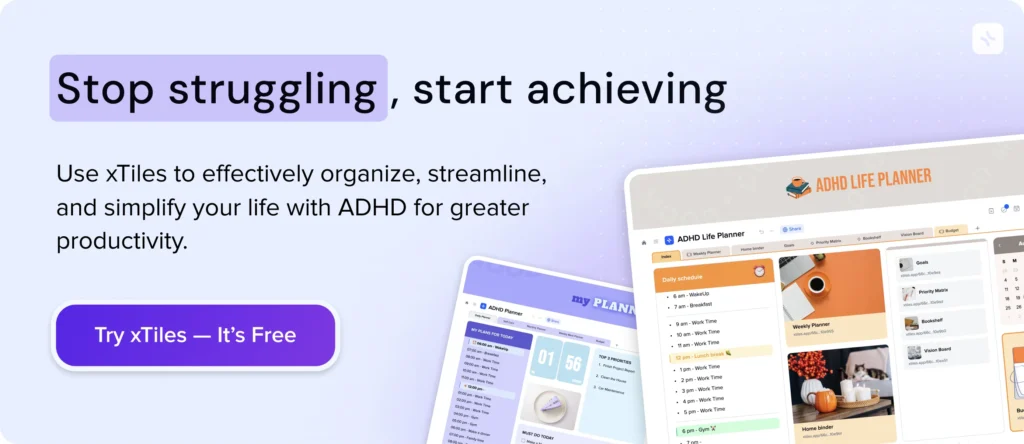
FAQ
How can xTiles help individuals with ADHD improve productivity?
xTiles is an adaptable visual platform tailored to the needs of people with ADHD to help them be more productive. It tackles common ADHD challenges like attention span and time management by offering customizable planning tools, visual organization features, and integration to help with task management, work prioritization, and focus.
What specific features of xTiles are beneficial for people with ADHD?
xTiles custom creative pages, visual layout options, task management integration, and document and collection creation are some of the key features that make it perfect for people with ADHD. With these tools, users can use color coding and visual cues, organize information in their preferred way of thinking, and break tasks into manageable steps – all of which can help reduce ADHD symptoms.
How does xTiles support time management for ADHD users?
With features like timeline views, Google Calendar integration, and built-in timers for work sessions, xTiles helps people with ADHD manage their time. These features address the time blindness many people with ADHD experience by helping users organize their time, visualize task sequences and deadlines, and get an overall view of their commitments.
Can xTiles help manage both short-term and long-term projects for ADHD users?
Yes, xTiles can help ADHD users manage both short and long-term projects. Its flexible approach offers tools to break down long projects and create daily to-do lists for urgent tasks. It is useful for managing projects of all sizes and duration because of its visual organization and ability to create hierarchies between different components.
